|
|
Sid, Sylvia and The Cavaliers

Carroll Smith, Tommy Ruble, WNOE MC Jim Stewart, Ron Stovall and Sid
Holmes in Poplarville, MS - 1959
Photo © Sid
Holmes
In the summer of 1959 while Scotty was promoting
Thomas Wayne at a record hop in
Poplarville, MS they were backed by Sid Holmes' Cavaliers. Originally from
San Angelo they formed in 1956 inspired by seeing Elvis, Scotty and Bill
perform there in 1955. By 1959 they had been in New Orleans promoting Sid's instrumental
Crazy Guitar. Recorded at a small label, Jane, in Dallas under the name of Billy
(the)
Kidd (the name in stickers on Sid's Fender Telecaster), the record was
not widely distributed or readily available. However, at the time, his
sister Sylvia worked in radio at WFYE in New Orleans and after sending her
some of the promos she added it to the station's play list. Through
her they received invites to perform in New Orleans and elsewhere.1
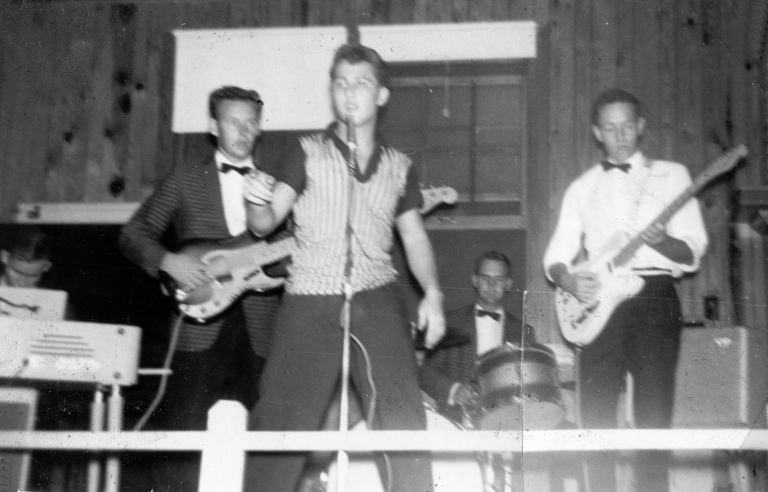
Carroll Smith, Frankie Ford, Ron Stovall and Sid Holmes in Poplarville, MS - 1959
Photo © Sid
Holmes
Born in Winters, TX and a graduate of The Pasadena Playhouse College of
Theater Arts in California, Sylvia Holmes was working at KDUB-TV when
Connie B.
Gay hired her for his fifth and latest Town and Country affiliate,
station WYFE
in New Orleans. Gay, who had made his name in the Washington and
Virginia area, had only a couple of years earlier declined an
opportunity to manage Elvis. He had been buying up radio stations around
the country, expanding his network and is credited as being one of first
to coin the term "country music."1
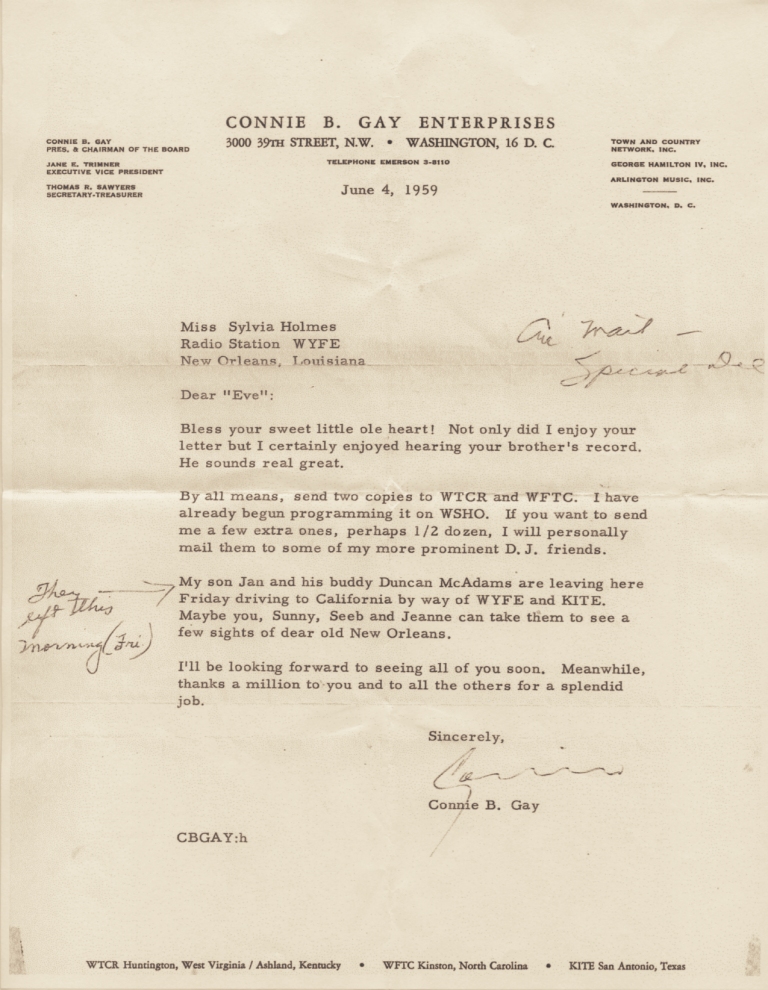
copy of the response letter sent by Connie B. Gay requesting copies of
Sid's record
courtesy Sid
Holmes
As one of three female broadcasters at WYFE nicknamed "Dawn," "Sunny"
and "Eve" to correspond to their shifts (morning afternoon and evening),
Sylvia (Eve) worked the evenings in addition to being the stations' music
director which made her popular with distributors and artists looking
for airplay. An attractive girl, she was asked to pose on renown New
Orleans Clarinetist Pete
Fountain's album,
Pete Fountain Day. Sylvia had
also sent copies of Sid's record to Gay which elicited a favorable
response and request for more but lacked any to send. Sid feels he
missed a golden opportunity.1

Carroll Smith, Ron Stovall, Frankie Ford and Sid Holmes in Poplarville, MS - 1959
Photo © Sid
Holmes
When WNOE-TV in New Orleans began sponsoring record hops the Cavaliers were invited to
participate where the backed such artists as Frankie Ford, of Sea
Cruise fame, and Thomas Wayne. This lineup consisted of Tommy Ruble on vocals, Carroll
Smith on bass and Ron Stovall on drums. After the show in Poplarville,
MS they returned to New Orleans and Wayne road with them. Sid thinks
that when Scotty returned to Memphis he put in a good word for Sylvia
and not long after she was offered a spot at WHHM in Memphs,1
the country station where "Sleepy Eyed" John Lepley had popularized
Elvis'
Blue Moon of Kentucky as Dewey Phillips had That's Alright Mama at WHBQ.
In fact, by 1959 Dewey himself had started at WHHM.
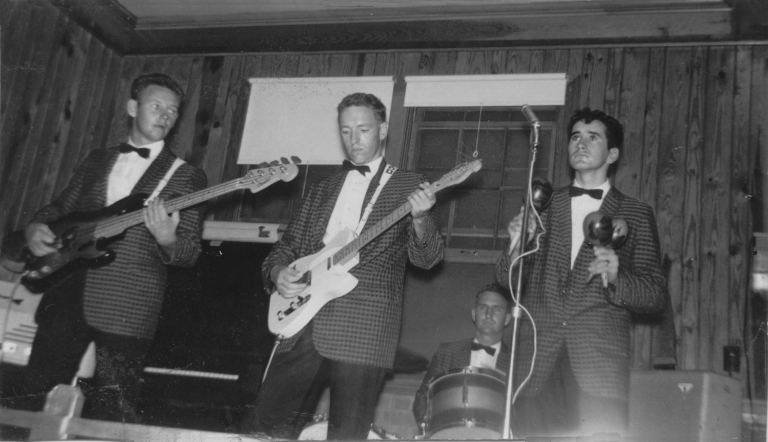
The Cavaliers, Carroll Smith, Sid Holmes, Ron Stovall and Tommy Ruble in
Poplarville, MS - 1959
Photo © Sid
Holmes
When Sylvia took the job in Memphis, Sid and Tommy Ruble also relocated.
Carroll Smith returned to San Angelo, eventually playing with various
Western Swing bands while Ron Stovall returned to West Texas, graduated
from college and worked for the State of Texas. In Memphis Sid found out
how many first rate players were there and would organize a new lineup
for the Cavaliers, two of which were Ed Logan on sax and Bobby Stewart
on bass. Logan would later play with Bill Black's Combo and through
Stewart they met Ace Cannon and ultimately Bill Black. With Logan they
also recorded at Fernwood Studio
backing his friend, Charles Eldred, who unfortunately would be killed
not long after along with a drummer returning from a gig with Ace Cannon.1
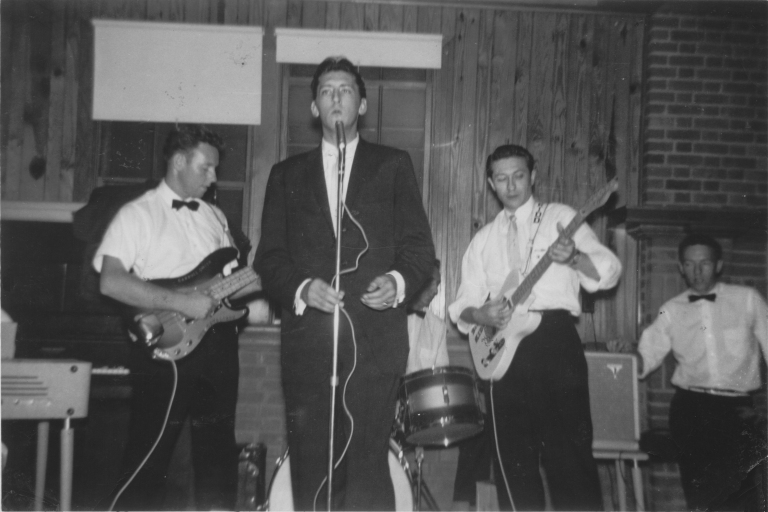
Carroll Smith Ron Stovall and Sid Holmes if the Cavaliers
back Thomas Wayne and Scotty at a record hop in Poplarville, MS - 1959
Photo © Sid
Holmes
At WHHM Sylvia was given the midnight to 6:00 a.m. spot. Her show “Sylvia
By Candlelight” was a combination of music, poetry and interviews.
Sam Phillips and Charlie Rich would become
regular visitors but one of her first and favorite interviews was with
Bill Black. She would give credit to Scotty and Bill whenever she played
Elvis' music and not long after Bill called her. She invited him to her show
and they had an hour-long conversation recalling his many experiences on
the road with Elvis and Scotty touring West Texas in 1955. In
March of 1960 after Elvis returned form the Army Sylvia heard that he
jokingly told reporters he had plans of using the Boston Pops Orchestra
as his new back-up band. She commented on the air that he didn’t need
the Boston Pops Orchestra; he just needed Scotty and Bill. Elvis called
immediately to assure her that he had been joking and followed it up
with an early morning visit during one of her shows wearing a tux and a red satin
cummerbund after watching a movie. Before leaving, Elvis said she would
always be welcome to visit at Graceland.1

Thomas Wayne and Scotty (with Sid Holmes' guitar) backed by Carroll
Smith and Ron Stovall of the Cavaliers - 1959
Photo © Sid
Holmes
For a time Sylvia became a regular at Elvis' late night events with fans
and friends, at the movies, roller rinks, fairgrounds and amusement park
and later incorporated into her show a green corduroy bullfrog shaped
bean bag that Sid had given her called Hugo. She introduced Hugo on her
radio show as Elvis' biggest fan and when Elvis broke his little finger,
Hugo wore a bandage. Reflecting Elvis' lifestyle, when Elvis wore a yacht cap, Hugo wore one
too. It caught the fancy of her listeners while also intriguing Elvis. Elvis
gave Hugo a wristband with the initials E.P. and when presented with a rare toy poodle from
London, he named it Hugo. In an interview for TV Star Parade magazine
when inquired about pets at Graceland Elvis was quoted as saying a
chimpanzee named Scatter, a myna bird and a toy poodle named Hugo. The
Poodle is named for a frog, a toy frog that belongs to his friend
Sylvia. It is speculated that Elvis may have given the poodle to his
future wife Priscilla who renamed it.1

Scotty with Sid's Telecaster, Tommy Ruble and Sid Holmes behind him -
1959
Photo © Sid
Holmes
Though Sylvia suggested it, Sid never attended any of the visits with
Elvis. He did however become friendly with Bill Black and at Sam
Phillips' new studio was present for Jerry Lee Lewis' recording of
What'd I Say. By 1962 Sid had relocated back to San Angelo and not
long after, Sylvia moved to Hollywood.1
Tommy Ruble stayed in Memphis and over the next forty years became a
popular performer and frequent performer at Memphis Nightspots. Bill E.
Burk, while a columnist for the Press-Scimitar, once wrote, “I
have seen Tommy sing softly and make women cry. I have seen Tommy sing
upbeat and fill dance floors. I have seen Tommy sing inspirationally and
cause whole crowds to become silent." Tommy died at the age of 62 of
liver cancer.2 Sylvia later returned to
Texas becoming the program director at KTXS-TV in Abilene. In 2012, Sid
published Rockabilly Heaven. It
recounts the music history of West Texas in the 1950s and tells the
story of the Cavaliers from 1956 - 1964.
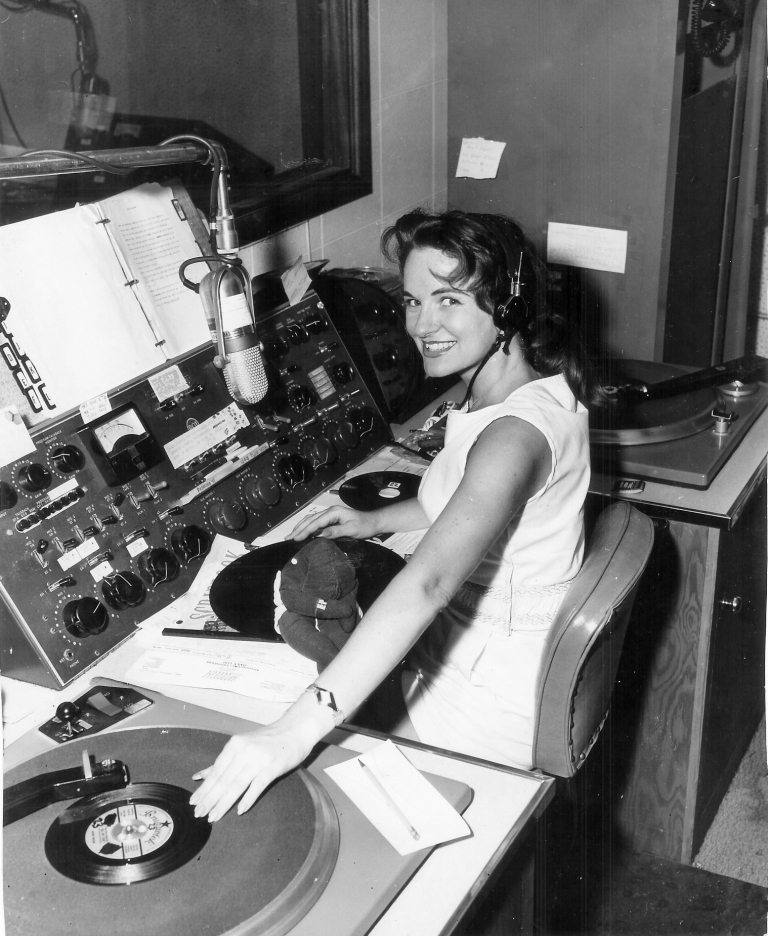
Sylvia Holmes and Hugo wearing his Elvis given E.P.
wristband at WHHM Radio in Memphis - 1960
Photo courtesy Sid
Holmes
added March 19, 2014
1 as told by Sid Holmes, Sylvia Holmes and/or published
in Rockabilly Heaven. We thank
them for their input and the use of their photos.
2 according to Thomas Ruble obituary in the Commercial appeal by Michael
Lollar, courtesy Sid Holmes
The King
Abilene woman got glimpse of Elvis when he wasn't
wearing a crown
By SYLVIA WYSOCKI
Staff Writer
|
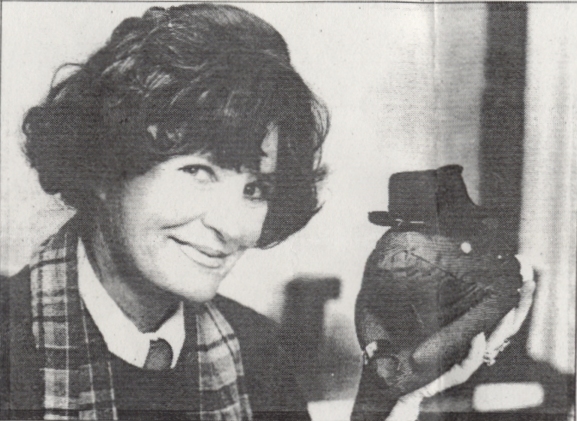
Ken Ellsworth/Reporter-News |
|
Sylvia Holmes and Hugo, onetime Elvis
copycat |
Elvis. Handsome, sexy, famous for his grinding hips and soft sultry
voice, he transformed the music world int he'50s and‘60s and inspired
fans who made him a legend
before and after his death.
Graceland, his home in Memphis, Tenn., is a monument where fans from all
over the world travel to keep his spirit alive.
But beneath all the glamour - the glittering facade Hollywood adopted
for him - who was the real Elvis?
On the 50th anniversary of his birth. Abilene, resident Sylvia Holmes,
program director at KTXS-TV, can offer a glimpse at the real man. Ms.
Holmes, a Winters native, said she was a of the superstar in the early
'60s.
"He was a kind of a sad person in a way," she said, twisting her mouth
ruefully. “He didn't know if people liked him for himself. He'd always
say. ‘Do they really care for
me for myself — or for the Elvis Presley that became the superstar?' ”
“And most people didn't know this,” she added. "But Elvis told me he
really couldn't play the guitar very well ... His instrument was the
piano. He was a great piano player.
"His main desire was to be an actor," Ms. Holmes" said. He wanted to do
more serious stuff but I guess they wouldn't let him.... He didn't like
the films he made."
She explained "He wanted to do more in his life than just be Elvis
Presley the rock ’n' roll singer. He didn't mean for his life to stay in
the same mold."
Ms. Holmes said she met Elvis when she was a late-night disc jockey for
WHHM-Radio, Memphis.
Though she had previously met the original members of Elvis’ band
through the station — Bill Black, Scotty Moore and D.J. Fontana -- she
said. "I didn't meet Elvis until one night, he listened to my show and
called me up."Later that night. at 3 a.m., he came over to the station. "I couldn’t
believe it. He came to the station at 3 a.m., and he was all dressed up
... in a tuxedo, she said, with a wistful giggle.
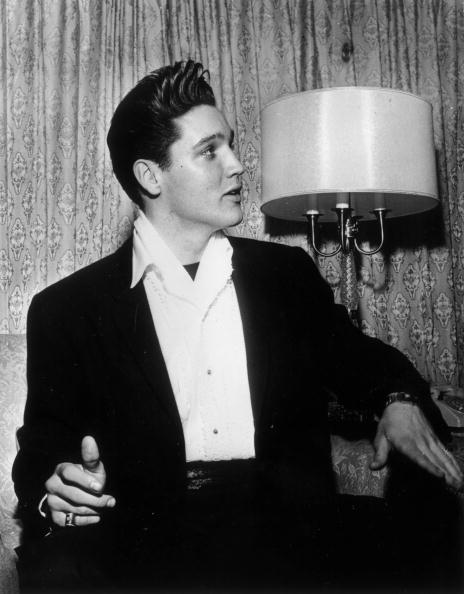
Elvis in tuxedo shirt and cummerbund - 1960
Photo courtesy FECC/the fool
After that, he invited her to Graceland, and she became one of the 50 or
so friends Elvis socialized with when he was in ‘town.
Ms. Holmes participated in late night skating parties, movie showings
and trips to the fair in Memphis.
“The way it was set up, we would all go to Graceland and sit around
until Elvis decided what he wanted to do that night.
“It's funny — or now it's funny — at about 1 a.m.. when everyone else
was asleep and the streets were deserted, you'd see a long line of cars
following the Cadillacs on the way to wherever we were going that night"
"Elvis always had a Cadillac," she sighed with a smile.
The parties would last all night . Elvis rented the fairgrounds, movie
houses and the skating rink for their exclusive use.
She explained that he’d send a limousine to take her over to Graceland
for these outings. “I was like his sister, and he respected my opinion
about music. He also talked to me personally." Ms. Holmes stressed that
there was no romantic involvement His girlfriend at that time was Anita
Wood.
She said the parties were not conducive to talk, with all the people
around. "If you know him, you knew the rules. You don't take a camera
wherever he's around. You don't ask for an autograph, and you always
laugh at his jokes."
“It was so artificial," she said, remembering a trip in the car to one of
his parties. "Elvis cracked a joke and everyone, though it wasn't funny,
laughed anyway," she explained.
Their first deep conversation, she recalled, took place in one of the
smaller rooms of Graceland. Elvis talked of his future plans, his
problems and his family.
“You wouldn't believe he'd have had such problems. But he was very shy
and uncomfortable around a lot of people, so he kept a lot of people he
knew around him to keep himself from the ones who made him
uncomfortable," Ms. Holmes explained.
She said he was also very bossy. “Elvis was a paradox in that he was shy
but forceful when things weren't the way he thought they should be.
“I saw a young man overwhelmed by the whole situation and who wasn’t
prepared for what came to him," Ms. Holmes said.
"What really impressed me," she said. "was his devotion to his family.
He had such a love of his family he wanted to have them around all the
time."
Ms. Holmes said Elvis never got over his mother's death.
"He bought Graceland for his mother. It was always a symbol of family to
him."

Elvis and Joan Blackman on the set of
Kid Galahad - 1962
The second conversation she recalled took place years later in
California when Elvis was shooting “Kid Galahad," a film about a boxer.
"He had me over when he heard I was in California, and he played all his
new songs for me," she said, dimpling.
“I told him my favorite song, and he said it was his favorite, too. It
was "Can’t Help Falling in Love (With You).”
He said he wanted to make it a single, but the recording company was
against it. Finally, months after the meeting, he persuaded the company
to release it, she said.
The California visit was the last time Ms. Holmes saw Elvis.
A memento of their friendship, however, sits within her direct line of
vision in her office - Hugo, a dark green corduroy bean bag frog with
white button eyes.
Hugo initially was a prop in Ms. Holmes’ radio show. After meeting
Elvis, however, Hugo became Elvis‘ “greatest fan.”
“Everything that happened to Elvis happened to Hugo." explained Ms.
Holmes. He came to be that “great fan” after Elvis broke a finger in a
karate match, and Ms. Holmes decided to bandage one of Hugo's "fingers"
in sympathy.
After that, Hugo had a Holmes-designed wardrobe of every movie Elvis
ever made. He wore a yachting hat when Elvis bought a boat and wore a
yachting hat, etc., she said. 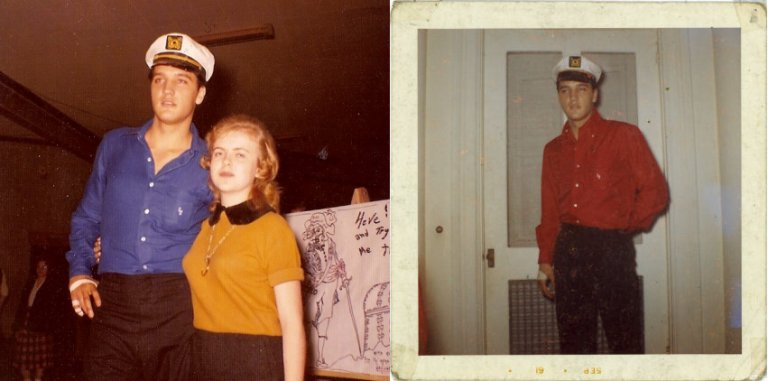
Elvis at Rainbow Rollerdome in Memphis with fan and
elsewhere, finger bandaged and wearing yachting cap - ca. 1960/61
Photos courtesy FECC
Learning this, Elvis wanted to meet Hugo, Ms. Holmes said, and he
awarded him a black karate band with initials E.P. that he gave to many
of his friends. Hugo wears
it, she said.
Hugo also came along with the gang on some on their outings.
“One time." Ms. Homes said, "it was so funny. We took Hugo to the
skating rink, and Elvis and I skated along with Hugo, Elvis holding one
of Hugo's arms while I was holding the other."
In commemoration of Hugo, she said, Elvis had a dog named Hugo II.
And many years later, she said, when she thought Elvis had forgotten
her, a cohort at a San Angelo radio station where she was then working
didn't believe she knew Elvis. So at a Houston press conference he asked
the superstar about Ms. Holmes.
“Elvis asked him where I was and if I still had Hugo," she laughed.
Ms. Holmes graduated from Kermit High School in Kermit and later
attended the Pasadena Playhouse in California, where she majored in
television.
Of her association with the superstar, she said, “l was there. I was
part of it, but I couldn't really comprehend who he was."
"I wish I had pursued my conversations with him further because he
needed people who cared about him."
Ms. Holmes said Elvis’ death was a tragedy. “First, because he was so
young (42),” she said, “but more because I knew that Elvis had a great
deal more that he wanted to do. "
article from the
Abilene Reporter
News, January 1985, courtesy Sid Holmes
added March 19, 2014
|













